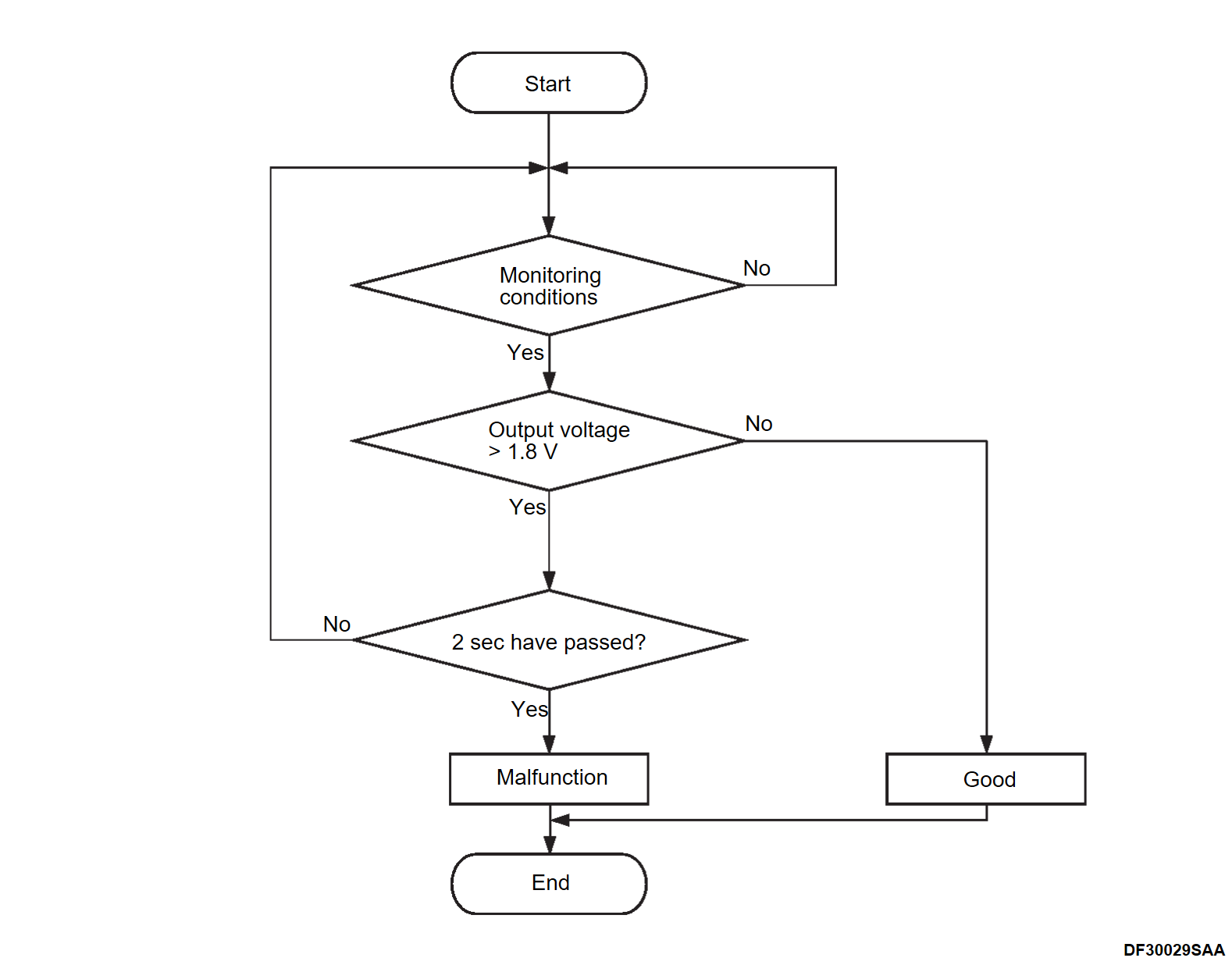DTC P0138-00: Oxygen Sensor (rear) circuit high voltage
CIRCUIT OPERATION
- The sensor signal is inputted to the ECM connector terminal number 49 from the heated oxygen sensor (rear) connector terminal number 4.
- The heated oxygen sensor (rear) connector terminal number 3 is grounded with ECM connector terminal number 50.
- The ECM connector terminal number 50 applies an offset voltage of 0.5 volt to the heated oxygen sensor (rear) connector terminal number 3.
TECHNICAL DESCRIPTION
- The output signal of the linear air-fuel ratio sensor is compensated by the output signal of the heated oxygen sensor (rear).
- The ECM checks for the heated oxygen sensor (rear) output voltage.
DESCRIPTIONS OF MONITOR METHODS
Heated oxygen sensor (rear) output voltage is over specified range.
MONITOR EXECUTION
Continuous.
MONITOR EXECUTION CONDITIONS (Other monitor and Sensor)
Other Monitor (There is no temporary DTC set in memory for the item monitored below)
- Linear air-fuel ratio sensor monitor
- Linear air-fuel ratio sensor heater monitor
- Heated oxygen sensor (rear) heater monitor
- Heated oxygen sensor offset voltage monitor
Sensor (The sensor below is determined to be normal)
- Mass airflow sensor
- Engine coolant temperature sensor
- Intake air temperature sensor
- Barometric pressure sensor
- Fuel tank pressure sensor
DTC SET CONDITIONS
Check Conditions
- More than 2 seconds have passed since the power supply mode of the electric motor switch was ON.
- Heated oxygen sensor offset voltage is between 0.4 and 3.8 volts.
Judgment Criterion
- Heated oxygen sensor (rear) output voltage has continued to be higher than 1.2 volts for 2 seconds.
FAIL-SAFE AND BACKUP FUNCTION
None.
OBD-II DRIVE CYCLE PATTERN
Refer to Diagnostic Function, OBD-II Drive Cycle – Pattern 2 OBD- II DRIVE CYCLE .
.
 .
.TROUBLESHOOTING HINTS (The most likely causes for this code to be set are:)
- Heated oxygen sensor (rear) failed.
- Shorted heated oxygen sensor (rear) circuit or connector damage.
- ECM failed.
DIAGNOSIS
Required Special Tools:
- MB992744: Vehicle communication interface-Lite (V.C.I.-Lite)
- MB992745: V.C.I.-Lite main harness A
- MB992747: V.C.I.-Lite USB cable short
- MB992748: V.C.I.-Lite USB cable long
1.STEP 1. Using scan tool (M.U.T.-III SE), check the data list.
Use scan tool (M.U.T.-III SE) to check the data list (Refer to DATA LIST REFERENCE TABLE ).
).
 ).
).- Item number A1501: Oxygen sensor(bank1 sensor2)
Q: Is the check result normal?
2.STEP 2. Check harness between heated oxygen sensor (rear) connector terminal number 4 and ECM connector terminal number 49.
Check output line for short circuit. Repair or replace the connector, or repair the damaged harness wire.
Repair or replace the connector, or repair the damaged harness wire.
Q: Is the check result normal?
 Repair or replace the connector, or repair the damaged harness wire.
Repair or replace the connector, or repair the damaged harness wire.3.STEP 3. Check harness between heated oxygen sensor (rear) connector terminal number 3 and ECM connector terminal number 50.
Check ground line for short circuit. Repair or replace the connector, or repair the damaged harness wire.
Repair or replace the connector, or repair the damaged harness wire.
Q: Is the check result normal?
 Repair or replace the connector, or repair the damaged harness wire.
Repair or replace the connector, or repair the damaged harness wire.4.STEP 4. Using scan tool (M.U.T.-III SE), check the data list.
Use scan tool (M.U.T.-III SE) to check the data list (Refer to DATA LIST REFERENCE TABLE ).
). Replace the heated oxygen sensor (rear) (Refer to ENGINE, Engine, Motor and Emission Control – Emission Control – Exhaust Gas Purification System CATALYTIC CONVERTER REMOVAL AND INSTALLATION
Replace the heated oxygen sensor (rear) (Refer to ENGINE, Engine, Motor and Emission Control – Emission Control – Exhaust Gas Purification System CATALYTIC CONVERTER REMOVAL AND INSTALLATION ).
).
 ).
).- Item number A1501: Oxygen sensor(bank1 sensor2)
Q: Is the check result normal?
 Replace the heated oxygen sensor (rear) (Refer to ENGINE, Engine, Motor and Emission Control – Emission Control – Exhaust Gas Purification System CATALYTIC CONVERTER REMOVAL AND INSTALLATION
Replace the heated oxygen sensor (rear) (Refer to ENGINE, Engine, Motor and Emission Control – Emission Control – Exhaust Gas Purification System CATALYTIC CONVERTER REMOVAL AND INSTALLATION ).
).5.STEP 5. Test the OBD-II drive cycle.
After erasing the DTC, carry out test drive with the drive cycle pattern, and recheck the DTC. Replace the ECM (Refer to ENGINE CONTROL MODULE (ECM) REMOVAL AND INSTALLATION
Replace the ECM (Refer to ENGINE CONTROL MODULE (ECM) REMOVAL AND INSTALLATION ).
). Intermittent malfunction (Refer to GENERAL INFORMATION, General Information – How to Use Troubleshooting/Inspection Service Points – How to Cope with Intermittent Malfunctions HOW TO COPE WITH INTERMITTENT MALFUNCTIONS
Intermittent malfunction (Refer to GENERAL INFORMATION, General Information – How to Use Troubleshooting/Inspection Service Points – How to Cope with Intermittent Malfunctions HOW TO COPE WITH INTERMITTENT MALFUNCTIONS ).
).
(1) Use scan tool (M.U.T.-III SE) to erase the DTC.
(2) Carry out test drive with the drive cycle pattern (Refer to Diagnostic Function, OBD-II Drive Cycle – Pattern 2 OBD- II DRIVE CYCLE ).
).
 ).
).(3) Use scan tool (M.U.T.-III SE) to recheck the DTC.
Q: Is DTC P0138-00 set?
 Replace the ECM (Refer to ENGINE CONTROL MODULE (ECM) REMOVAL AND INSTALLATION
Replace the ECM (Refer to ENGINE CONTROL MODULE (ECM) REMOVAL AND INSTALLATION ).
). Intermittent malfunction (Refer to GENERAL INFORMATION, General Information – How to Use Troubleshooting/Inspection Service Points – How to Cope with Intermittent Malfunctions HOW TO COPE WITH INTERMITTENT MALFUNCTIONS
Intermittent malfunction (Refer to GENERAL INFORMATION, General Information – How to Use Troubleshooting/Inspection Service Points – How to Cope with Intermittent Malfunctions HOW TO COPE WITH INTERMITTENT MALFUNCTIONS ).
).![[Previous]](../../../buttons/fprev.png)
![[Next]](../../../buttons/fnext.png)
